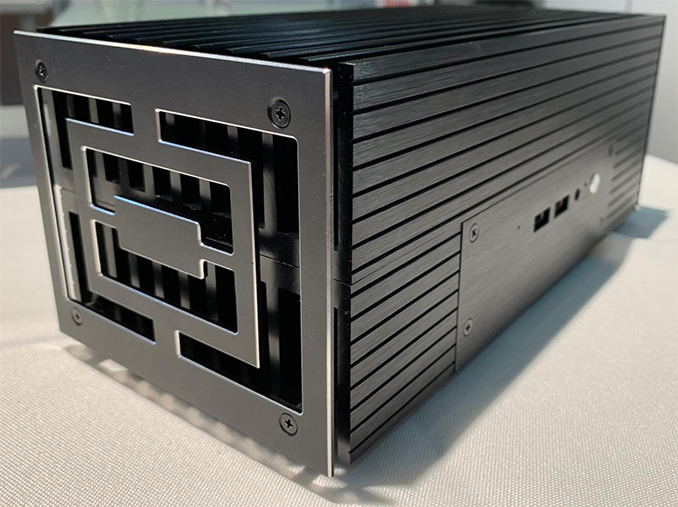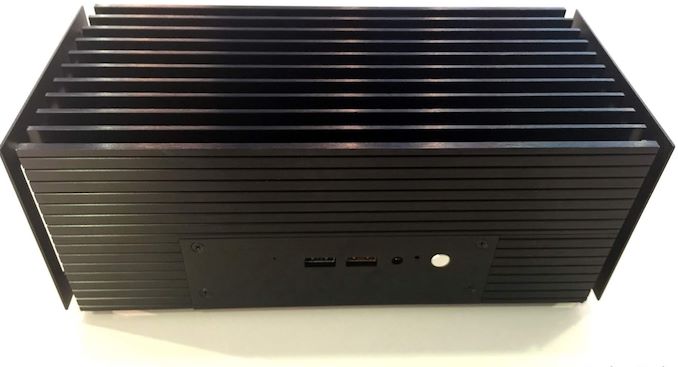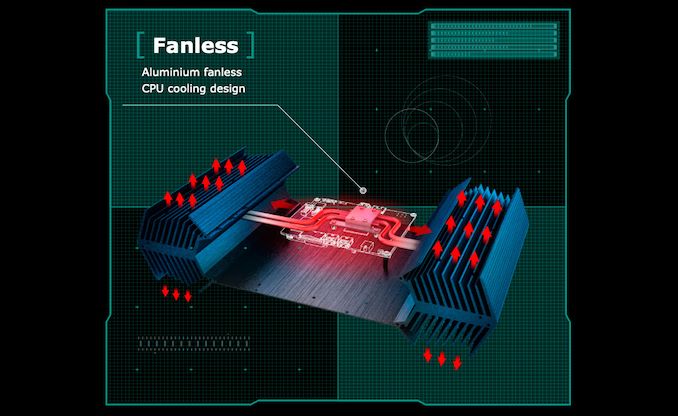Akasa's Turing: A Passively-Cooled Chassis for Intel’s Bean Canyon NUC
by Anton Shilov on February 8, 2019 3:00 PM EST- Posted in
- Desktop
- Cases/Cooling/PSUs
- Passive Cooling
- Chassis
- Cases
- Akasa

Akasa is prepping an aftermarket chassis for Intel’s 8th Gen "Bean Canyon: NUC systems. The Turing chassis will allow Intel’s NUC 8 ultra-compact form-factor (UCFF) computers to be converted to fanless systems, eliminating the noise that they produce.
Intel's Bean Canyon NUC systems are based on the company's 8th Gen Core i3/i5/i8 processors, which offer two or four cores as well as Iris Plus Graphics 655 (GT3e) iGPU. Theu are designed for users who need better graphics performance in a very compact form-factor. Apart from a 28 W CPU, Bean Canyon PCs also pack up to 32 GB of DDR4 memory, an M.2-2280 PCIe 3.0 x4 or SATA SSD, a 2.5-inch storage device, a Thunderbolt 3 controller to plug in an external graphics or storage sub-system, a 802.11ac Wi-Fi solution, and just about everything else that one comes to expect from an UCFF PC. Needless to say, the compact system packs a lot of heat, and as a result it uses a blower-based cooler in order to keep it in check
However Akasa has decided to do one better, and is putting together a chassis for Bean Canyon that allows the NUC to be converted into a passive, silent system.
Akasa is already known for its Galactico chassis (its scheme is depicted below) for Intel’s Skull Canyon NUC aimed at users seeking for UCFF gaming PCs. Based on the pictures of the Turing case published by FanlessTech, the upcoming chassis for Intel's Bean Canyon uses the same principle as its predecessor: it has a large CPU heat exchanger featuring multiple heat pipes that transfer heat from the processor to massive radiators. While the Galactico features two aluminum radiators located on the sides of the chassis, the Turing features an additional radiator above the CPU as well.
Quite naturally, Akasa’s Turing and Galactico chassis make Intel’s NUC systems considerably larger than they originally are, but they eliminate all the noises that these PCs produce. Furthermore, they retain all the I/O ports that the computers have, including GbE, USB Type-A/Type-C, TB3, HDMI, DP, audio, microSD, and even antennae fitting holes.
According to FanlessTech, Akasa will launch its Turing chassis shortly. Pricing is uknown, but it is likely that it will be comparable to a ~$200 MSRP of the Galactico.
Related Reading:
- Intel Officially Launches Bean Canyon NUCs with Coffee Lake-U Processors
- Intel’s Crimson Canyon NUCs with Cannon Lake CPU & Radeon dGPU Available for Pre-Order
- The Intel NUC8i7HVK (Hades Canyon) Review: Kaby Lake-G Benchmarked
- Intel NUC8i7HVK (Hades Canyon) Gaming Performance - A Second Look
- The Intel Skull Canyon NUC6i7KYK mini-PC Review
Source: FanlessTech













27 Comments
View All Comments
PeachNCream - Friday, February 8, 2019 - link
That passive upgrade adds a lot of size to a NUC which might run counter to the intent of obtaining a small computing platform. I'm not saying the idea of a passively cooled computer is a bad one, but targeting the NUC with a physically bulky cooling product seems like a confluence of poorly thought out decisionmaking.Operandi - Friday, February 8, 2019 - link
This makes total sense. If you want relatively high performance in silent form factor in an attractive package a NUC plus one of these cases will provide that. If you want the ultimate in compactness where low noise isn't the priority then this is obviously not something you are looking at anyway.More to the point these types of high-end passive cases are meant to be show pieces not hidden away. It dosn't look like its excessively large for its intended use cases (HTPCs and silent desktop setups).
808Hilo - Saturday, February 9, 2019 - link
Thats an awful lot of ribbed alu profiles loosely connected to the cpu. Most of them have no part in cooling. Radiating heat is about surface,not mass. Then its just a heatsink. I file it under styling execerciseolde94 - Monday, February 11, 2019 - link
The thermal resistance is directly related to the thickness of the blades, so you need some (not too much) to transfere the heat when the plates are pasively cooled.jeremyshaw - Friday, February 8, 2019 - link
Also, does it take that much metal to passively dissipate 30W? Unless if Akasa has unlocked the CPU, Intel usually set rather conservative limits on their NUCs.Even so, I remember having a passively cooled HD4650 and GTX750Ti (both in open air builds - no CPU fan either!) either of which have to dissipate a lot more then 30W.
Death666Angel - Friday, February 8, 2019 - link
Those GPUs were likely run out of spec then. :D When I was looking at this sort of thing, the manufacuteres mandated that you have sufficient case ventilation. This Akasa case has to run like this guaranteed in all kinds of environments. Better safe than sorry is their approach.PeachNCream - Sunday, February 10, 2019 - link
It really doesn't require anything close to that much metal. I've had lots of laptops powered by 35W TDP mobile processors over the years and most of them run at least partly passive on much smaller heat pipe and radiator combinations in an airflow constrained laptop chassis. That's part of the reason why I question the size increase. a 28W TDP CPU like the one this is meant to cool could be passively cooled by a properly designed heatsink that is approximately the same size as the original NUC casing it replaces.Death666Angel - Friday, February 8, 2019 - link
This can be useful for someone who wants an off the shelf solution to a totally silent, maintanence free system with a bit of power and does not mind the larger size. Or for hazardous environments with lots of dirty, dust and whatever buildup where no moving parts can survive long.cfenton - Friday, February 8, 2019 - link
How much noise does a NUC usually make? I have an old 35W Ivy Bridge USFF computer from HP and it's really quiet. I assume NUC's would be even quieter since they are a lot newer and tend to use lower TDP CPUs.Still, I love the idea of a completely passively cooled system with no moving parts.
wintermute000 - Saturday, February 9, 2019 - link
USFF form factors is considerably larger than a NUC